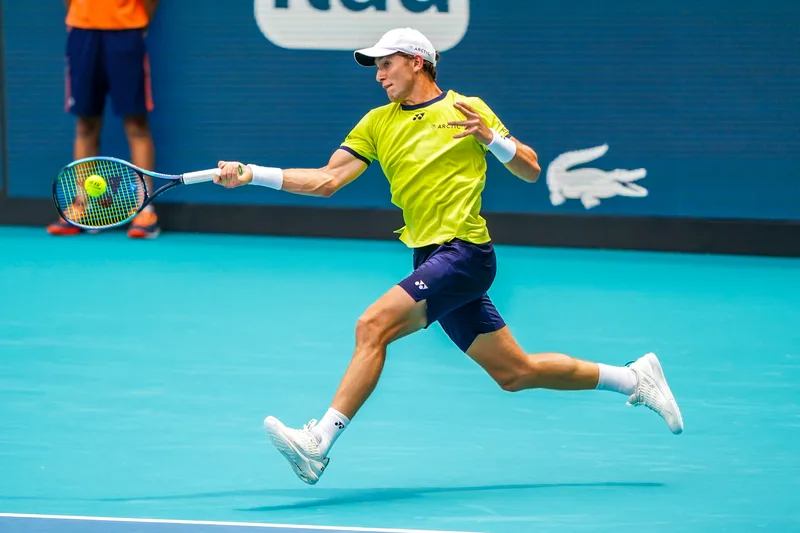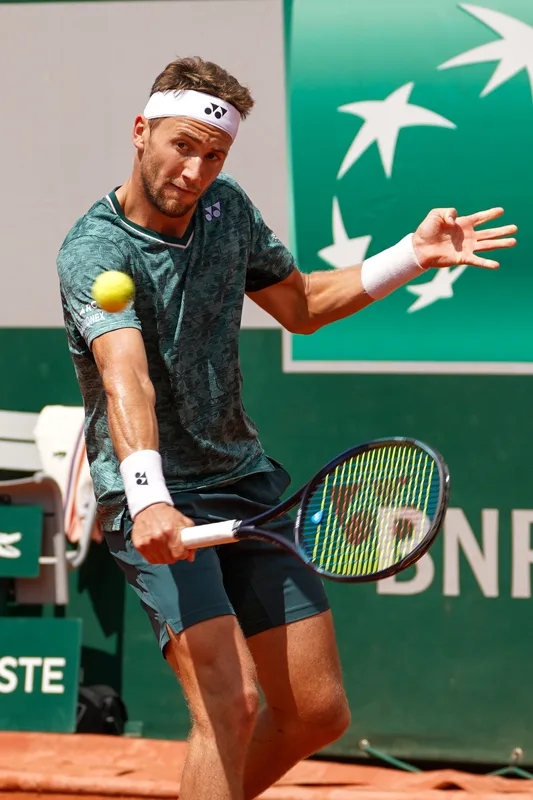
He’s had a year that will cement his career in tennis history in 2022 and is only twenty-three. Casper Ruud’s two grand slam finals after previously only reaching the round of sixteen at the Australian Open in 2021.
His peak ranking of second in the world was obviously a career-high and is indicative of his consistent performance throughout the year. Boasting a heavy forehand with some of the highest RPM readings on tour, Casper can bully opponents around the court.
Of course, that kind of a forehand weapon serves him well on clay, but he’s comfortable on hard courts too due to his upbringing in Norway where the climate required him to play a good deal of tennis indoors. Ruud has been training at the Rafael Nadal Academy for most of his professional career, which shows in his clay court success.
Prior to the last couple years, he enjoyed most of his success on the dirt, and it’s refreshing to see him translate his game so well to the gritty asphalt of hard courts too.
He’s currently participating in the World Tour Finals before gearing up for the 2023 season. Now that we know a bit about his career, let’s dig into his equipment.
Here’s Casper Ruud’s racquet setup:
- Endorsed Racquet: Yonex Ezone 100+ 2022
- Actual Racquet: Yonex Ezone DR 100+
- Strings: Yonex Poly Tour Spin 125 mains and Yonex Poly Tour Pro 125 crosses @ 54 pounds
Which Racquet?
Casper used an extended length Babolat in his early junior days and switched over to the Yonex DR 100+ before he hopped on the tour. He’s been using the same racquet underneath various paintjobs since.
The Ezone 100 has not changed much since its inception, and though the DR version was maybe a tad softer than what’s currently out today it’s not strikingly different: it’s a tweener style frame similar to a Babolat Pure Drive with a slightly softer response and plenty of spin and power on tap, especially in the extended length version Ruud plays.
Casper probably hasn’t updated his frame because like most pros he wants to keep things the same. There have been no obvious signs of testing other racquets. Given his recent huge year it wouldn’t make sense for him to change much.
This racquet amplifies his heavy, spinning groundstrokes and allows him some extra pop on serve and leverage on his double handed backhand. It’s a good fit for the best qualities of his game, like we see with most professional players.
The larger headsize and thick beam allow for better forgiveness on off-center hits and give the racquet a greater ceiling for producing quality shots when not perfectly positioned, though Ruud is often set up well for the ball.

- We can see pattern on Casper’s bumper guard matches that of the Ezone DR 100
Specs
Casper plays with a fairly common racquet spec that we’re finding with up and coming pros – lighter and more maneuverable than traditional professional racquets that are super heavy and headlight.
He keeps the swingweight high enough for stability and power with the balance geared toward even to keep mass in the head of the racquet. Casper plays approximately the following specs:
- Strung mass: 330g
- Strung balance: 33.5 cm
- Strung swingweight: 340
This is a fairly light racquet, but the 340 swingweight and more head heavy balance along with his racquet’s extended length give Casper loads of leverage over the ball which results in his insane amounts of topspin and weight of shot.
A spec like this requires precise footwork because so much of the weight is up near the head of the racquet. It can get a bit unwieldy compared to a 340 swingweight with most of the mass in the handle. But Casper moves very well and has little problem with the demanding nature of his frame.
Strings
Casper employs a hybrid of two different polyester strings which has become a bit more popular on the tour in the past few years.
He uses the shaped Yonex Poly Tour Spin 16L in the mains and the slick, smooth Yonex Poly Tour Pro 16L in his crosses at 54 pounds as confirmed in professional tournament stringing records.
- Stringing log from the 2021 Erste Bank Open in Vienna, Austria
The slippery, round polyester crosses allow the shaped mains to move further and then snap back quickly on impact, providing more spin potential and a slightly softer feel than a round string in the mains would.
At the pro level with their fast swings, a shaped string makes less of a difference than it does for recreational players, but Casper obviously likes it, and it may play into the spin he generates.
His 54 pounds is a bit on the higher side for full polyester these days, so if you’re a recreational player trying to duplicate his setup, consider dropping the tension a few pounds!
Conclusion
This hardworking Norwegian has a racquet and string setup that perfectly compliment his spin-oriented baseline game. He gets plenty of extra power and spin from his racquet’s large head size and extended length, allowing him to control baseline exchanges with his huge forehand.
The length and power help him on his serve too, and we consistently see him pumping the gun at 130+ mph (yes, this is in large part due to his fitness and skill, but extended length racquets do serve better than standard ones).
I don’t see Casper changing anything as he continues to build on his greatly successful 2022 season. We should see him gunning for major titles for the better part of the next decade, Yonex in hand!
If you’re interested in other ATP players’ racquets, I listed all the top 100 players’ racquets in this post.
